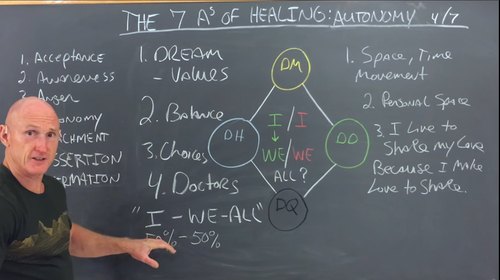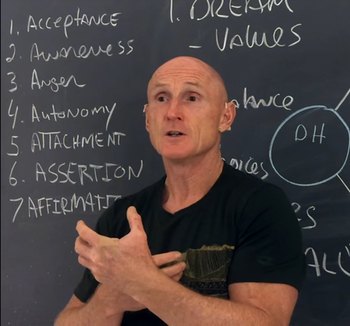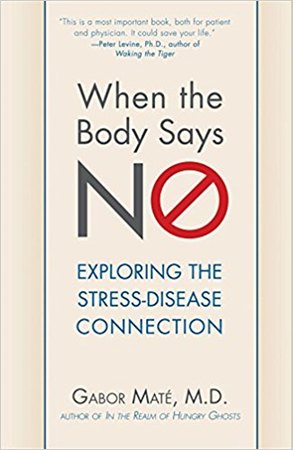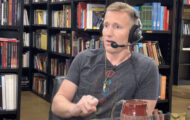The Seven A’s of Healing Part 4: Autonomy
Happy Monday morning to you all. Before you start prepping for your holiday week with friends and family in America or wherever you may live in the world, I want to talk about autonomy, the subject of part 4 of my Seven A’s of Healing series.
When we talk about autonomy, that means having a healthy sense of your self or I. When we use the word I, we’re referring to our self.
Someone who has a healthy sense of autonomy is in touch with who they are. They’re in touch with what their needs are and capable of meeting them effectively.

All of that sounds great, but there’s negatives associated with autonomy too. Being overly self-reliant can create great problems when we don’t ask for help when we need it, like guys who don’t ask for directions when they’re lost.
That over-reliance can become really problematic for people with health challenges who don’t ask for help, especially among men who exhibit this behavior way, way too often.
(As a guy who used to own a physical therapy clinic, I’m far more impressed with how women would come to me for help before all hell had broken loose, while men wait until they’re practically disabled to ask for assistance!)
On one side, we’re too autonomous to the point that we don’t effectively engage in relationships and that causes problems for us on any dream team.
On the other side of negativity, you may lack autonomy and that leads to codependency. If you’re the codependent person, that puts you in a place where you need someone else to make you feel happy. And, if they don’t do things the way you like them all the time, you may want to cut them off from sex or any number of things.
Codependent relationships are entangled relationships and they’re uncomfortable to be in. Often, people in codependent relationships have a hard time being autonomous enough to state what their real wants, feelings, needs and dreams are. This information is critical in determining if harmony or a mutual dream can exist to hold the relationship together.
Five choices you must make in any relationship
Typically, there’s five things you can do in a relationship:
- Work on yourself, which would be to take responsibility for your 50 percent of the relationship.
- Work on the relationship, which means seeing it as something bigger than either of you as individuals, especially if you have kids.
- Do nothing and know that yesterday equals tomorrow. That’s Groundhog Day, so the past will equal the future.
- Get out of the relationship because you have enough autonomy to know what your real authentic needs are and can be honest with your partner.
- You may choose to work on yourself and the relationship, but that rarely works because most people don’t have enough energy to work on both. Usually, I suggest that people always start with themselves first because they own those responsibilities. Later on, they can work on their relationships when they’re healthy enough to know what they really want, what their values really are and what they’re really willing to contribute.
Being an active participant means maintaining a 50/50 relationship. If I’m missing about 10 percent of the time in a relationship, there’s 10 percent of me you cannot access and part of me I can’t give to you.
That lack of commitment creates a 20 percent deficit in any relationship and enough of a gap to create significant problems, like divorce or getting fired.
Being healthy

Another reason having a sense of autonomy is vitally important: In order to be healthy, we have to be clear about what our dream is.
If we don’t know what our dream is, we really don’t have any reason to create happiness and grow ourselves spiritually and commit to the work of growth in a relationship.
Without a dream, we don’t really have any motive or inspiration to possess the values we need to have for creating happiness and better health.
If we’re not careful, we can easily become codependent and allow somebody else to take responsibility for things that we’re not willing to do ourselves, which creates a burdensome source of stress and disease for them.
From that point onward in my vlog, I’ll share a few things you need to have to be healthy and autonomous. For some of you, these things may sound completely unattainable.
Just know that if you’re reading this right now, you’ve already taken the first step toward owning your autonomy, learning what It takes to become a more complete person and building stronger relationships.
Coming next time in part 5, we will discuss the importance of attachment, along with some of the disorders that can occur with people who have problems in their autonomy, their relationships and with people in general.
Resources

I’ll remind you one more time that this series is based on Dr. Gabor Mate’s awesome book, When The Body Says No: Understanding The Stress-Disease Connection.
I can’t recommend this book enough, especially if you’ve been diagnosed with a disease, have a disease in your family that you’re coping with as a caregiver or want to prevent the disease and realize the common things that lead to disease.
If you haven’t picked up a copy of my book, How to Eat, Move and Be Healthy, the new second edition features an overview of my 4 Doctors model and takes you through specific exercises to help you get clear on each of those components.
My book contains some important questionnaires that will help you identify where you’re out of balance, then help you formulate a clear plan of execution.
My hope is that, being reading my book and taking those actions based on the answers you give in those questionnaires, you’ll be far more able to live your dream and experience balanced, healthy living and generate more love to share with other people and the world.
Have a wonderful week!
Love and chi,
Paul














Find me on the web